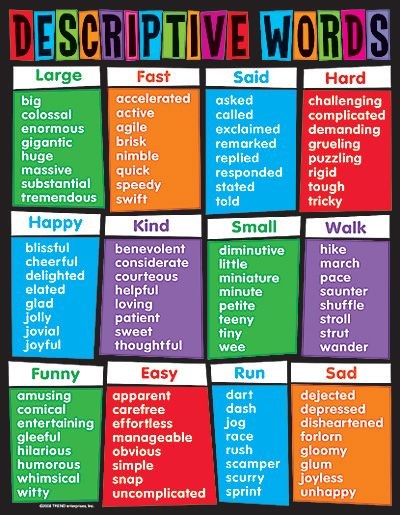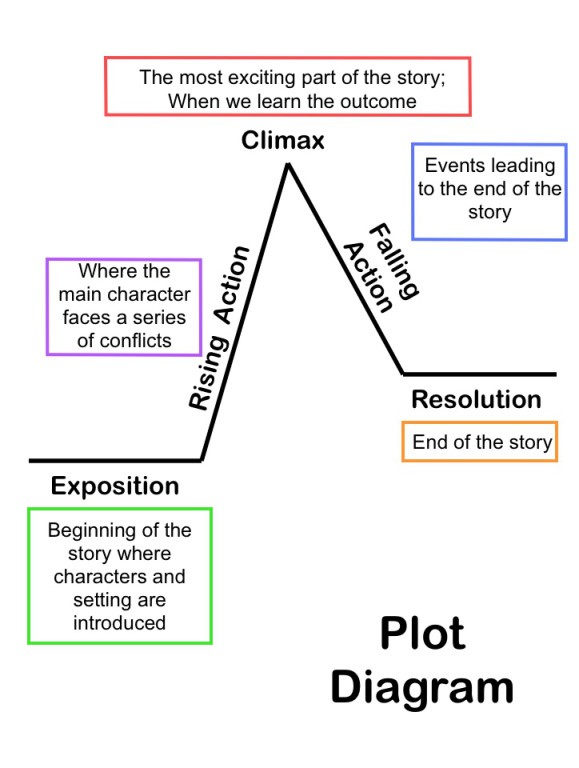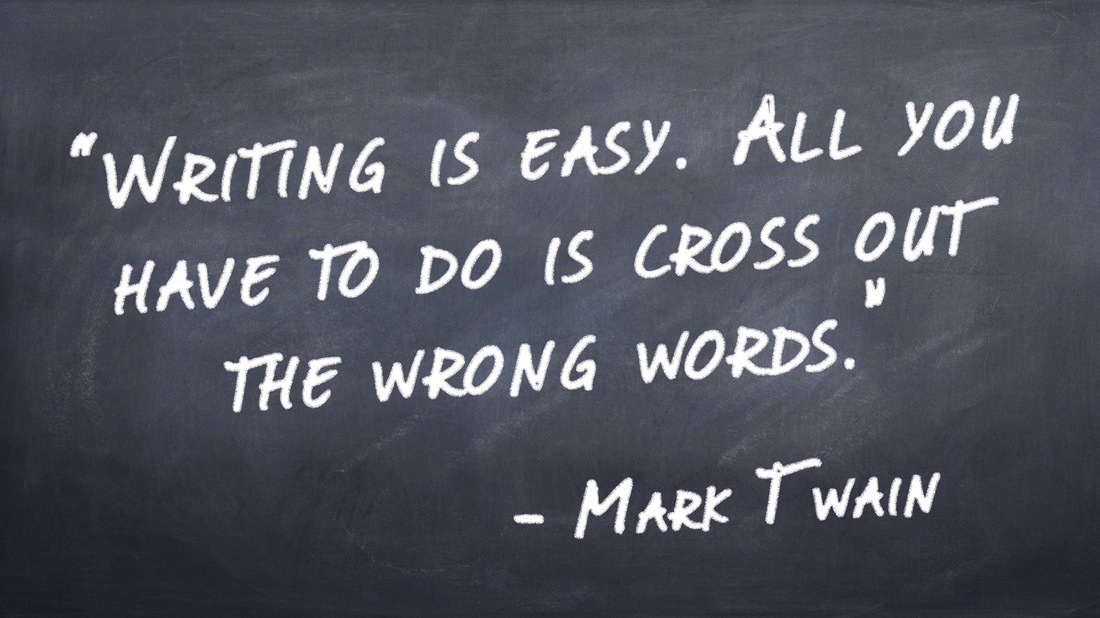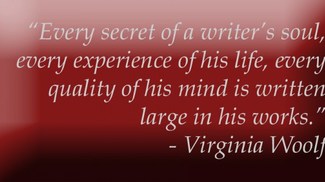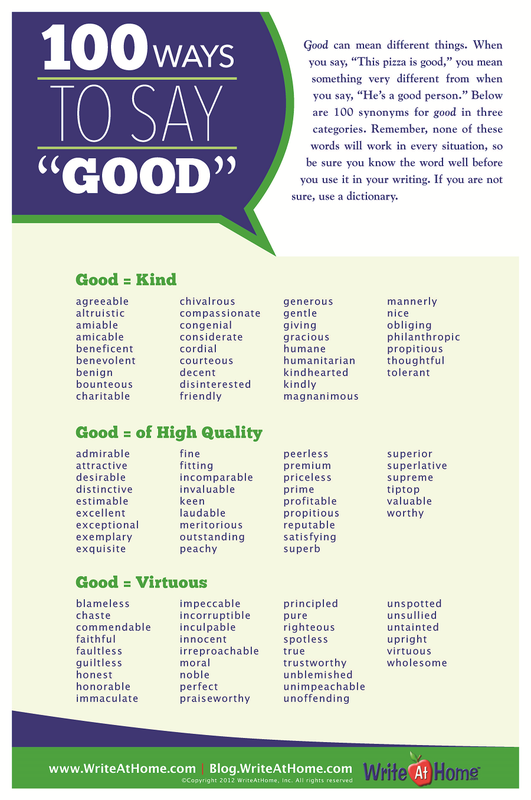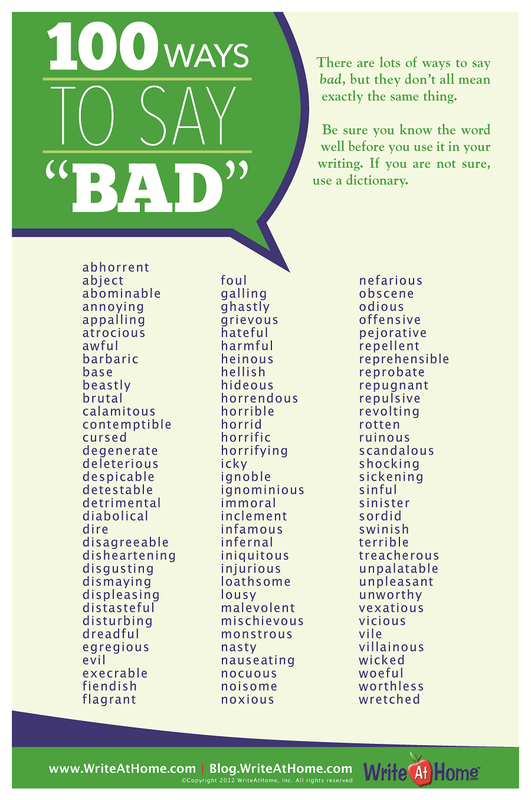|
What makes someone a good writer? Can anyone really be taught to write? To begin to understand what makes writing, and writers, “good,” we need to ask: “What is writing?”
The definition of writing could be something like “putting pen to paper” or “typing ideas into a computer.” But we all know that it is not as simple as that. In this writing course we will help you students to be better writers by following simple “rules”, so use your imagination, get your computer ready and get writing :-)
|
Writing tipsHere you can find a selection of words that you may use when you are writing your text. The quizlet is called "How to write": https://quizlet.com/join/cjpSVttuQ 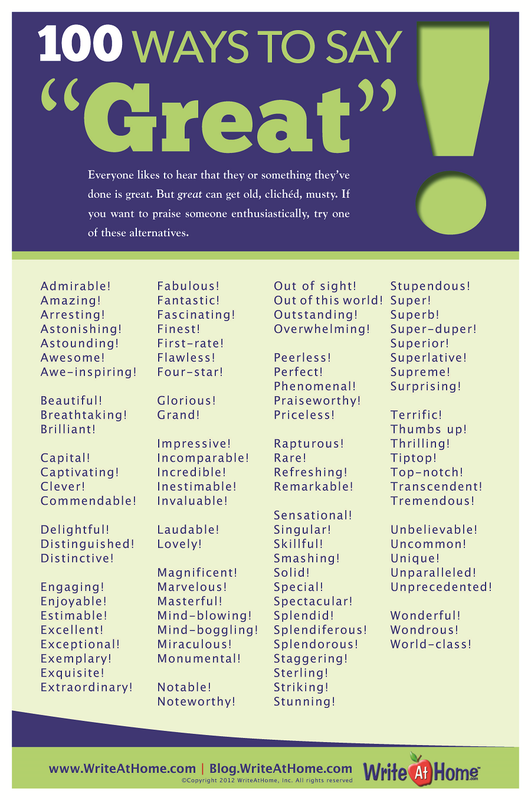
In the texts above you find charts with words that vary your language: 100 ways to say GOOD, BAD or GREAT! |
STORY-WRITING TIPS:
Part One: Ideas
People often wonder where writers get their ideas for stories. It takes so many ideas to make a story or a novel! Here is a secret: writers do not think of all those ideas. They steal them! Not really, but they find ideas from many sources and combine them to make an original story.
Part Two: Sketch the "basics" of your story
These are the basics of all stories:
1. Sympathetic character
2. Who faces a problem
3. Character solves problem
Don't get into details, but have an idea of your main character and the conflict.
Part Three: Fill in the details: Character and Conflict
Character
First, build your main character. Here are important traits of a main character:
Conflict -- a storyteller's best friend
The classic conflicts: These are ideas to get you started.
Tips on creating conflict:
Part Four: Planning the Plot
Character and conflict are the heart of your story. The plot is just the sequence of events that happen as the character faces problems. Here are a few things to remember about plotting:
Elements of most plots
Plan these scenes and you should be ready to write. I have used examples from the movie Shrek.
Part Five: Plan your scenes
Scenes: how you show your plot
Dialogue
Dialogue does many things for your story:
Part Six: Write
I do not write until I've planned my character, conflict, scenes, and especially my opening. In your rough draft, just concentrate on getting it all on paper. You can go back and fix things later.
Part Seven: Revise
It is important to correct spelling and grammar mistakes, but first, make sure your story is in good shape. Look at your plan again and make sure that you showed those things in your story. Here are two examples:
Sometimes writers plan a great character, but reread their rough draft and discover they left out important information about the character. Check that you showed the character's problem, strengths, and weaknesses.
Sometimes writers find that important parts of their BIG SCENE were not properly set up earlier in the story. For example, if your character solves a riddle in the big scene, you need to show earlier in the story that your character is good at riddles.
Part One: Ideas
People often wonder where writers get their ideas for stories. It takes so many ideas to make a story or a novel! Here is a secret: writers do not think of all those ideas. They steal them! Not really, but they find ideas from many sources and combine them to make an original story.
- Look for ideas in real life, such as funny quotes, interesting people, or occurrences at school.
- Consider your favourite stories. You can use elements of them to make a new story.
- Brainstorm! Combine several ideas to form the basis of a new story. For example, Harry Potter-books combine school, sports, destiny, a kid in a "Cinderella" type situation, battles between good and evil, and magic to create compelling stories.
Part Two: Sketch the "basics" of your story
These are the basics of all stories:
1. Sympathetic character
2. Who faces a problem
3. Character solves problem
Don't get into details, but have an idea of your main character and the conflict.
Part Three: Fill in the details: Character and Conflict
Character
First, build your main character. Here are important traits of a main character:
- Has a problem or need.
- Has the ability to solve the problem, whether or not he knows it (there's usually more suspense if he doesn't).
- Often has a flaw to overcome to solve the problem or win the reward.
- Villains: Block the main character from reaching goals. (The Green Goblin in Spider-Man)
- Allies: Assist the main character in reaching goals. (Robin in Batman)
- Mentors: Wise characters that help the main character. (Obi-Wan Kenobi in Star Wars)
- Jokers: Lighten things up! Often the main character's best friend is a joker. (Donkey in Shrek)
Conflict -- a storyteller's best friend
- The stronger the story problem, the stronger the story.
- Do not be nice to your character! Create obstacles to the goal. The story is more exciting that way, the character learns more, and the reward is more valuable since the character worked so hard for it.
The classic conflicts: These are ideas to get you started.
- Person versus person: The most popular, since conflicts between people are the most interesting to readers. (Example: Cinderella and her wicked stepmother)
- Person versus himself: Conflict between good and evil or strengths and weaknesses in a character. This is deep stuff and not usually the main conflict. (Example: The Grinch is evil and hates Christmas, but he is not evil at heart -- he is like that because someone hurt him. The Grinch feels inner conflict over the good and evil inside of him.)
- Person versus nature: Usually involves natural disasters or survival skills. This conflict is exciting, but often difficult to write about at length. (Example: The character in Jurassic Park must survive in and escape from a dangerous land of dinosaurs.)
Tips on creating conflict:
- Combine different types of conflict. Maybe your characters struggle to survive and fight among themselves.
- Add more conflicts and obstacles if your story seems slow or not "big" enough.
- Before you write, know how the problem will be solved. Do not write yourself into a hole!
- The main character must solve the problem. Do not have someone (or something) enter at the last minute and save the day.
Part Four: Planning the Plot
Character and conflict are the heart of your story. The plot is just the sequence of events that happen as the character faces problems. Here are a few things to remember about plotting:
- A plot is based on cause and effect.
- The plot follows the effects of the character's actions and decisions.
- Avoid a series of events. You want a chain of events, each affecting the next. Each link in the chain should be necessary to your story!
Elements of most plots
Plan these scenes and you should be ready to write. I have used examples from the movie Shrek.
- "Get the story going" event: Show character's problem & event that starts adventure. (Shrek's swamp is ruined when Lord Farquaad puts fairy tale creatures there. Lord Farquaad promises to remove the fairy tale creatures after Shrek rescues Princess Fiona.)
- Adventure scene(s): Meet friends & enemies, face obstacles, learn lessons, prepare for...(Shrek meets Donkey, they rescue Princess Fiona and set off for Duloc. Along the way, they become friends and have adventures, like fighting Robin Hood and his Merry Men.)
- The bog event: Everything is on the line. Most exciting part of story. (The wedding scene.)
- Wrap-up: Tie up the loose ends and hand out rewards & punishments. (Shrek marries Fiona, Donkey falls in love with the dragon, and Farquaad is eaten by the dragon.)
Part Five: Plan your scenes
Scenes: how you show your plot
- Decide how to show action, plot, character interactions, lessons characters learn, etc. Example: Do not just say, "Alex was shy." Have Alex demonstrate shyness by the way he interacts with others. Later, show Alex has gotten over his shyness by having him face someone he was previously afraid of.
- Each scene needs a beginning, middle, and end. See if you can use the end of one scene to transition to the beginning of another, and so on.
- Do not write a short scene for a major event, and do not make a scene out of something that doesn't need to be. Example: If several uneventful days go by as a character waits for important test results, do not write several day's worth of boring events. Skip to the test results and show the character has waited for days.
Dialogue
Dialogue does many things for your story:
- Reveals character (especially through reactions)
- Advances plot
- Brings scenes to life
- Adjusts the story's pace
- TAKES UP SPACE!!! (Start a new paragraph every time a new character speaks. This takes up space, which is useful if you need a story of a certain length.)
- Avoid long greetings and goodbyes. These slow the story and add little.
- Convey character by showing a character's reaction or way of speaking.
- Do not use dialogue as a substitute for action. Example: If you have an earthquake in your story, write a great earthquake scene with lots of action. Do not have a character say "Oh! An earthquake!" and leave it at that.
- Plan your setting -- know details about it. This makes your story more vivid.
- Setting helps you avoid "floating" scenes -- conversation or action that could be happening anywhere.
- Setting adds atmosphere to scenes. Example: In a beach story, a character might compare Aunt Mary's screeching to a seagull. In a city story, Aunt Mary might remind the character of a burglar alarm.
- In some books, the setting is like a character. Example: Survival stories like Gary Paulsen's Hatchet.
- Start with the day that is different -- the day the hero is called to adventure
- Start your story as close to the "big event" as you can
- Show the main character and the problem, or hint at the problem.
- Use action to get your story rolling and make your reader want to see what happens next.
Part Six: Write
I do not write until I've planned my character, conflict, scenes, and especially my opening. In your rough draft, just concentrate on getting it all on paper. You can go back and fix things later.
Part Seven: Revise
It is important to correct spelling and grammar mistakes, but first, make sure your story is in good shape. Look at your plan again and make sure that you showed those things in your story. Here are two examples:
Sometimes writers plan a great character, but reread their rough draft and discover they left out important information about the character. Check that you showed the character's problem, strengths, and weaknesses.
Sometimes writers find that important parts of their BIG SCENE were not properly set up earlier in the story. For example, if your character solves a riddle in the big scene, you need to show earlier in the story that your character is good at riddles.
